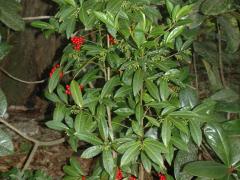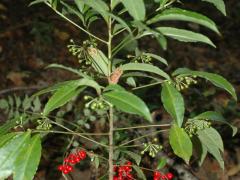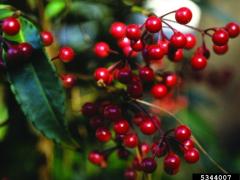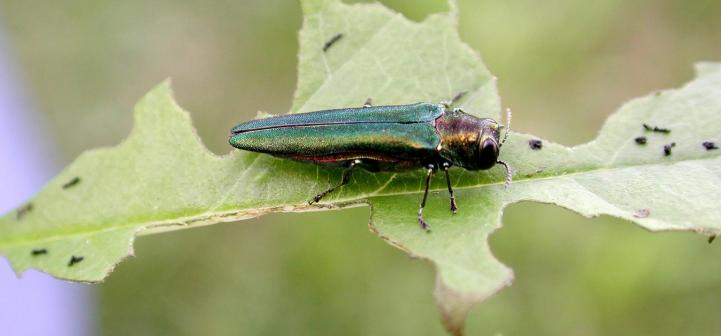Invasive Species: Ardisia crenata, Coral Ardisia
Coral ardisia is a small invasive shrub that ranges from 2 to 6 ft. (0.6 to 1.8 m) in height. The evergreen leaves are leathery, dark green, and 4 to 8 in. (10 to 20 cm) long. The pink to white flowers are inconspicuous and develop in the late spring and early summer. Fruit are persistent, deep red berries. The seeds are easily spread by birds. Coral ardisia thrives in shade and deep, rich soil but can survive in any non-saturated soil. This plant is a native of Southeast Asia and was introduced in Florida as an ornamental plant around 1900. Coral ardisia does not fare well in cold areas, as a hard freeze will kill the plant.
What are invasive species, and why should we be concerned about them?
Taxonomy: Scientific and Common Names for This Species
Primulales > Myrsinaceae > Ardisia crenata Sims
Synonym(s): hen’s eyes, coralberry
Ardisia crenata – USDA PLANTS Profile
Distribution Maps
coral ardisia – The reported distribution of this invasive species across the United States (Source: Invasive Plant Atlas of the United States)
Up-to-the-minute distribution maps and why they are important
Reporting This Invasive Species
What is the best way to report the occurrence of an invasive species?
How to report an invasive species sighting to EDDMapS – Early Detection & Distribution Mapping System
EDDMapS – Report an invasive species to EDDMapS.
County Extension Offices – Find your county Extension office on this map provided by USDA.
How to Identify
This invasive species can be identified by looking for the characteristics described in the following paragraphs.
Shrub
Coral ardisia is a small shrub that ranges from 2 to 6 ft. (0.6 to 1.8 m) in height.
 |
 |
| Chris Evans, River to River CWMA, bugwood.org | Ann Murray, University of Florida, bugwood.org |
Foliage
The evergreen leaves are leathery, dark green, and 4 to 8 in. (10 to 20 cm) long.
 |
 |
| Ken A. Langeland, University of Florida, bugwood.org | James H. Miller, USDA Forest Service, bugwood.org |
Flower
The pink to white flowers are inconspicuous and develop in the late spring and early summer.
 |
 |
| Ann Murray, University of Florida, bugwood.org | Chris Evans, River to River CWMA, bugwood.org |
Fruit
Fruit are persistent, deep red berries.
 |
 |
| Ken A. Langeland, University of Florida, bugwood.org | Steve Hurst, USDA NRCS PLANTS Database, bugwood.org |
Native Species That Resemble Coral Ardisia
– Images at invasive.org
| bugwood.org | bugwood.org |
– Images at invasive.org
| bugwood.org | bugwood.org |
Additional Images for Coral Ardisia
coral ardisia – Images at invasive.org
Learning Resources for Coral Ardisia
Recognition card – University of Florida, Institute of Food and Agricultural Sciences (IFAS) Extension, Center for Aquatic and Invasive Plants
Additional Information, Biology, Control and Management Resources
Control and management recommendations vary according to individual circumstances. Location, habitat, weather, and a variety of other conditions are factors that help determine the best treatment choice. To find the safest and most effective treatment for your situation, consult your state’s land-grant institution. If you will use chemicals as part of the control process, always refer to the product label.
United States Land Grant University System – Find your Land Grant University’s College of Agriculture, University Cooperative Extension Service, or other related partner on this map provided by USDA.
Invasive Species Management Plans for Florida – University of Florida, Center for Aquatic and Invasive Plants
Pacific Island Ecosystems at Risk
Invasive Plants – Global Invasive Species Database
Electronic Data Information Source – University of Florida, IFAS Extension
